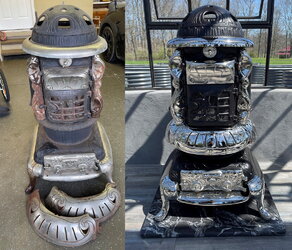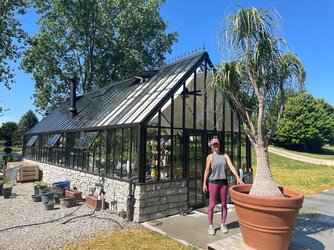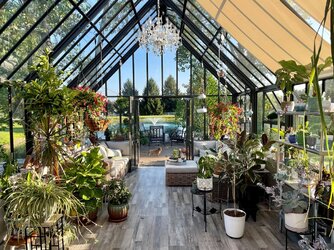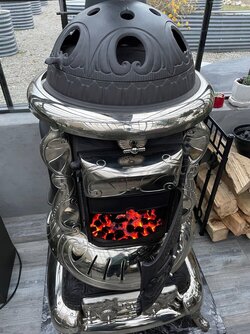My wife inherited her great-grandparent's antique wood stove. It's marked as Hamilton Stove Co with a patent date of 1905. It weighs about 300lbs. My wife remembers it from her childhood in the early 80's, but we have no idea how old it actually is. It's a family heirloom so I want to use it but I also want to keep it safe. I had it professionally refinished where it was taken apart, glass beaded, nickel plated, paint, caulked, and reassembled. I have attached the before/after photo and I'm really pleased with how it looks. We're using it in our 500 sqft glass greenhouse (photo attached) to supplement the propane furnace as wood is cheaper than gas. Yesterday was our first really cold day and I was impressed that it managed to heat the space to 56F when it was dark and 31F outside so that's great. I put a fan on the side of it to move air around the room and that kept the main body of the stove to about 600F.
I have many concerns though. Part of me thinks her family used this for fifty years without any issue and I probably can't hurt it no matter what I do because I doubt they paid it much mind or even had the tools to monitor it like I do. The other part of me with multiple thermometers including an IR one is watching the base by the embers glow a dull red and read just over 1,000F and worry it's about to shatter in half causing huge damage to itself and it's surroundings. Sometimes he body of it is 300F and I throw in a couple logs and five minutes later it's 800F so it seems really hard to control even with the dampers all the way closed down.
I've read many posts here and I see conflicting answers like some people saying never let it get above 600F and others saying, "mine glows red all day and has for twenty years without issue".
How do I know what a safe operating temperature is for this stove and will something catastrophic happen if I exceed it?


I have many concerns though. Part of me thinks her family used this for fifty years without any issue and I probably can't hurt it no matter what I do because I doubt they paid it much mind or even had the tools to monitor it like I do. The other part of me with multiple thermometers including an IR one is watching the base by the embers glow a dull red and read just over 1,000F and worry it's about to shatter in half causing huge damage to itself and it's surroundings. Sometimes he body of it is 300F and I throw in a couple logs and five minutes later it's 800F so it seems really hard to control even with the dampers all the way closed down.
I've read many posts here and I see conflicting answers like some people saying never let it get above 600F and others saying, "mine glows red all day and has for twenty years without issue".
How do I know what a safe operating temperature is for this stove and will something catastrophic happen if I exceed it?





